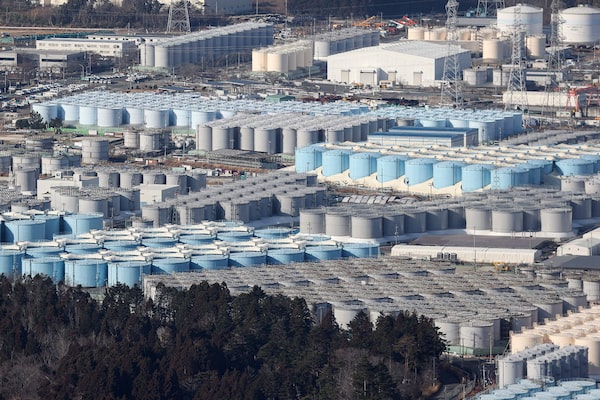
Storage tanks used for storing treated water at TEPCO's Fukushima Daiichi Nuclear Power Plant, at Okuma, Fukushima prefecture, Japan, on Feb. 14, 2021.STR/AFP/Getty Images
A team of experts from the UN nuclear agency inspected the tsunami-hit Fukushima Daiichi nuclear power plant Wednesday for a review of its discharge of treated radioactive waste water into the Pacific.
The International Atomic Energy Agency inspection was part of a four-day visit to Japan that started Tuesday, its second since the water discharge began last August despite strong protests from fishing groups and neighbouring China, which has banned Japanese seafood. The IAEA team will issue a report later.
The Japanese government and the plant operator, Tokyo Electric Power Company Holdings, or TEPCO, say the discharges are diluted to better than international standards, and IAEA chief Rafael Mariano Grossi said in March that they were being carried out safely.
During the site visit Wednesday, the plant suffered a temporary blackout when some underground digging apparently damaged an electrical cable in an area separate from the water discharge. The blackout halted the water discharges for several hours, but the IAEA was nonetheless able to complete its inspection, according to TEPCO.
One excavation worker suffered burns and had to be treated in hospital, but the plant’s cooling systems were unaffected and the water discharge resumed safely Wednesday evening, TEPCO said.
The IAEA did not immediately comment on the blackout.
A 2011 earthquake and tsunami damaged the Fukushima plant’s power supply and reactor cooling functions, triggering meltdowns of three reactors and causing large amounts of radioactive waste water to accumulate. After more than a decade of cleanup work, the plant began discharging the water after treating it and diluting it with seawater on Aug. 24, starting a process that’s expected to take decades.
After Wednesday’s plant visit, the IAEA team members are expected to have more discussion in Tokyo through Friday. Data and samples collected from the Fukushima plant will be corroborated at IAEA labs and independent third-party labs from China, South Korea, Switzerland and the United States, and will be released in a report later.
“This independent, objective and science-based approach will help build confidence to the people in Japan and beyond,” mission leader Gustavo Caruso, director of safety and security co-ordination at IAEA, said at a meeting Tuesday with Japanese officials.
The team includes independent international experts from 10 countries – Argentina, Australia, Britain, Canada, China, France, Russia, South Korea, the United States and Vietnam.
Japan’s government and TEPCO note that the treated water is filtered and diluted by large amounts of seawater. Results of monitoring of seawater and marine life samples near the plant show concentrations of tritium, the only inseparable radioactive material, are far below recommended limits, they say.
Fishing groups worry about a negative reputation from the release, and neighbouring China has not been convinced of the safety. China banned all imports of Japanese seafood immediately after the release began.
The plant has released about 31,200 tons of the treated water in four batches. The ongoing fifth batch of 7,800-ton release lasts through May 7.
Wednesday’s cable damage and blackout was a latest in a series of incidents at the plant in recent months. In October, two workers were hospitalized after being splashed with radioactive liquid while cleaning a water treatment system, though they had no health problems from the exposure. In February, some contaminated water leaked at another facility on the plant due to human error.